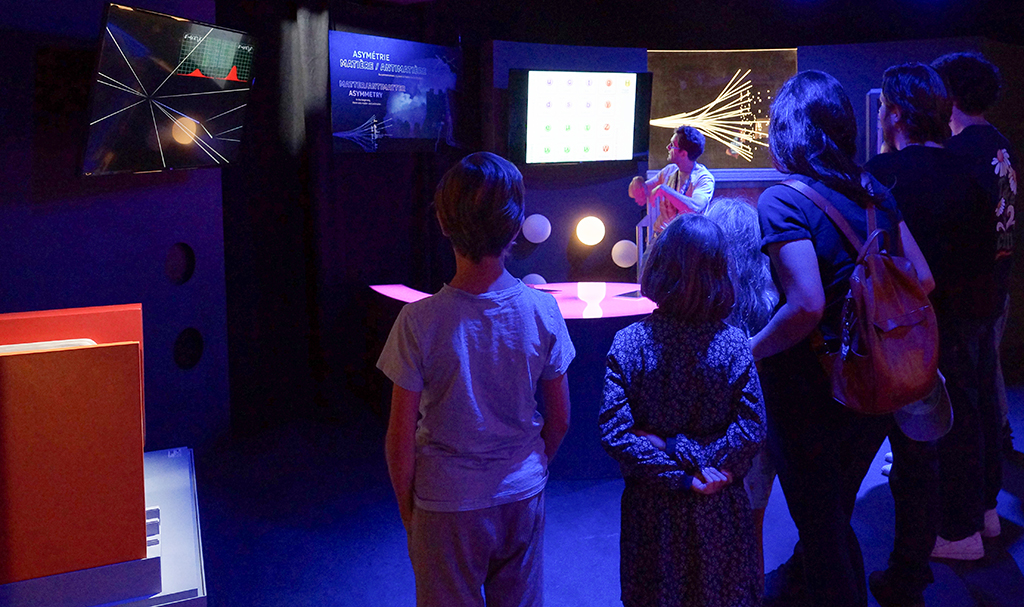EUTOPIA Discovery Center
The Eutopia museographic space, set up on LAPP and LAPTh premises, can be used to receive the public, present the laboratory’s activities and welcome local players.
EUTOPIA aims to open up science, the analytical and visionary skills of scientists and the cutting-edge technical expertise of research support staff to society.
The Eutopia project was born of LAPP’s desire to share its knowledge and scientific advances with the general public, and to make its scientific disciplines accessible to as many people as possible.

Guided tour
Visitors are guided through the different areas, where they are invited to interact with the laboratory’s researchers, engineers and technicians. The latter use the tools of their choice (multimedia content, models, technical installations, etc.) to address each theme.
Themes

The universe was born 14 billion years ago, in an event known as the Big Bang. Initially extremely dense and hot, it gradually cooled as it expanded. Tiny lumps of matter in this initial "soup" gradually gave rise to large cosmic structures populated by galaxies, themselves composed of hundreds of billions of stars. The study of their movement and evolution points to the presence of "dark matter", an elusive material whose nature is currently unknown. It also suggests the existence of mysterious "dark energy", responsible for the accelerating expansion of the universe over the past five billion years.

Born in a nebula, the smallest stars end their lives by slowly fading away like candles, becoming white dwarfs. The most massive die extremely violently, collapsing in on themselves. The remains of these stars, now neutron stars or black holes, sometimes collide with the relic of a companion star. This leads to tremendous explosions, ejecting matter, cosmic rays and light into space in the form of gamma-ray bursts. They also generate gravitational waves, tiny vibrations of space-time. By observing these messengers of the cosmos, scientists gain a better understanding of the violent phenomena that take place within it.

The world of the infinitely small is revealed in the laboratory: collisions of protons accelerated to close to the speed of light are creating new particles at CERN, some of which are unstable and only existed at the beginning of the universe.By studying their interactions, physicists are patiently mapping a world currently made up of twelve elementary bricks, four forces and the Higgs boson.As they search for new constituents of matter and study their novel properties, scientists cross-reference information gathered from gas pedals, nuclear reactors and cosmic rays.The key to this exploration: answers to unanswered questions about the infinitely large and the infinitely small.

For every particle of matter, there's its antimatter counterpart, an antiparticle. Their differences? Opposite physical properties, such as electrical charge. At the time of the big bang, as much matter as antimatter would have been created. Yet today, everything we perceive, from the smallest terrestrial life form to the largest stellar objects, is made almost entirely of matter. What happened to antimatter? Do we really understand the difference between the two? To answer these questions, a number of experiments are testing whether the physics is the same for matter and antimatter, and seeking to elucidate what happened in the early universe.
Contact
Eutopia Discovery Center was inaugurated in 2019 and has been financed by three local authorities (Greater Annecy, Haute-Savoie department and Auvergne-Rhône-Alpes region), by Grenoble Alpes University Excellence Initiative, by Labex Enigmass and by the laboratory’s two administrative authorities: CNRS and Université Savoie Mont Blanc. Within this immersive space, animated by researchers and engineers, LAPP offers all publics, from schoolchildren to the socio-economic world, an original space to discover physics in a different way.

